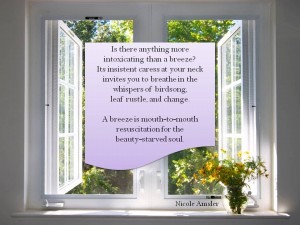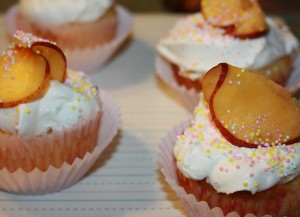Blog Posts
Twelve Days of Christmas for Authors
I am a huge advocate of writers. They are my heroes and rescuers, crafting worlds I can get lost in and telling stories which sooth the soul.
This Christmas consider the Twelve Days of Christmas for Authors. There are 12 simple ways you can help a published writer keep writing new worlds and keep the job they love, crafting stories you will love.
This tale is written from the viewpoint of any author who has invested hundreds of hours into a book which can get lost in a sea of a million other books. Find an author you love and adore and apply these gifts to them. You will make an impact and make their year.
On the first day of Christmas, my reader gave to me is one purchase of my book.
Libraries and half price books stores are wonderful. They allow books to be devoured and authors to be discovered. But if you love an author and want them to keep writing, buy their book. Buy it for yourself. Buy it as a gift. You would spend as much on a movie ticket or two, yet a book offers many more hours of entertainment.
On the second day of Christmas, my reader gave to me two hand sellers.
There is a special brand of angels called Hand sellers. These lovely rare creatures have their fingers on the pulse of the literary world and have read countless books. When readers enter their book store, library, or place of business, they are able to perform magical matchmaking, suggesting that specific reader would love this specific book. Make sure the hand sellers in your sphere of influence are aware of your favorite author(s). Tell them WHY you enjoy that writer so much. It will help her hand sell books to the perfect audience.
On the third day of Christmas, my reader gave to me three social media connections.
Consider following your favorite author on the trifecta of social media outlets: Facebook, Twitter and Goodreads. You will be able to connect with them on a personal level, learn about new projects they are working on, and encourage them with Likes and Retweets. Writing is lonely work. For some writers, checking in with their social media links is the carrot at the end of the stick after a long writing day.
On the fourth day of Christmas, my reader gave to me four gift purchases.
A book is always an excellent gift because it offers four advantages. The writer is read and heard, her goal when she started writing, never sure the book would sell or be read. The author and the publishing industry as a whole are bolstered by your purchase. The reader and gift recipient is transported to another world and gifted an additional life to live through the book’s pages. And the gift-giver (you) has another fan to discuss the book with and a potential fellow fan.
On the fifth day of Christmas, my reader gave to me five golden stars.
Reviews on Amazon, Barnes and Nobles, GoodReads and other places can help inform decisions. A five star rating is the best and depending on the system, a three star rating is actually a negative review. Not everyone is going to enjoy every book, so write your reviews and select your ratings carefully. Explain why readers like you would enjoy this book and what you enjoyed about it. Rank your very favorite books with five stars and a spoiler-free assessment of where the book succeeded. Your words are amplified and will carry to hundreds or thousands of potential readers. Your words have impact.
On the sixth day of Christmas, my reader gave to me six cover image shares.
There is a science to book cover artwork. And there is a cumulative effect of seeing a book’s cover multiple times across multiple forums. Add your favorite book to Pinterest, on multiple boards. Add the cover to your favorite reads on Facebook. Share a photo of the book as seen “in the wild.” Add the cover to your “Want to Read” list in GoodReads, and then mark it as “Read” when you’ve finished. Blog about the book along with the photo of the book cover.
On the seventh day of Christmas, my reader gave to me seven library requests.
Libraries are intensely helpful to authors. Many writers use the quiet space to write their tomes, others are on first-name basis with the librarians for research. There are so few avid readers left in the world, libraries are uniquely connected to readers and the reading lifestyle. Much like hand sellers, librarians are matchmakers and can use your input to help searching readers find their perfect book. If you request a book, librarians are made aware and will take notice.
On the eighth day of Christmas, my reader gave to me eight matches made.
Just like librarians and hand sellers, YOU, as a reader, can be a matchmaker too. When you see a movie, you instinctively know your best friend would love its off-beat humor but your mother would cringe at the sex scenes. You recommend the movie to your friend, but don’t mention it to your mother. There is no difference between you and Siskel and Ebert. Be a viral sensation. Tell readers about your favorite book. Be purposeful about it.
On the ninth day of Christmas, my reader gave to me nine public exposures.
If you have purchased the book, display its pretty cover when you read it in public. Take it on the bus or train; bring it to your dentist appointment or the BMV. A book sighting in the wild can drive sales as well as open conversation with others. If you read on a device such as Kindle or your iPad, consider sharing your reading choice digitally, such as on Twitter or Facebook.
On the tenth day of Christmas, my reader gave to me ten shelf leapings.
Do you know big box bookstores are specifically assigned to face certain books face forward to increase sales? You can be a super fan by facing your favorite author’s current book face forward in book stores everywhere you go. Word of warning: don’t move the book to a different section (such as the front of the store) because then the staff won’t be able to help customers find the book, hurting sales.
On the eleventh day of Christmas, my reader gave to me eleven book club readers.
Are you part of a book club? Your reading life will be transformed when you practice reading with conversation and dissection in mind. Books are meant to be devoured in community, like a good meal. If you don’t belong to a book club, consider finding or starting one. If you do belong to a book club, consider suggestion your favorite book. Many authors will happily attend your book club conversation via Skype.
On the twelfth day of Christmas, my reader gave to me twelve months of mentions.
Books today have a shortened life cycle. Much like movies, their “opening weekend” (or the first few weeks of sales) is crucial for setting the book up for long range success. Lackluster initial sales result in less publicity and hand selling. Early buzz and continued momentum can push a book from midlist level to best seller. Mention your favorite book more than once. Stay faithful for its first year, suggesting it to other avid readers, to book clubs, and to your library. When a book comes out in paperback (the equivalent of the DVD release), recharge your efforts.
For your favorite books and authors, these twelve gifts are a tremendous help. Writers struggle everyday to keep ahead of the ever changing landscape. Even performing one of these acts for your favorite author will put you on the permanent “Nice” list.
The Care and Feeding of Viral Posts
 We live in the age of viral posts, where everyday an under-the-radar blogger publishes a heart-felt post about {insert buzzword here} and suddenly find herself on morning talk shows, defending her view to a panel of experts.
We live in the age of viral posts, where everyday an under-the-radar blogger publishes a heart-felt post about {insert buzzword here} and suddenly find herself on morning talk shows, defending her view to a panel of experts.
The author of the viral post is lifted high with “atta-girls,” a flurry of Facebook Likes, and five minutes of trending on Twitter. In some cases, book deals are offered, careers are launched, and new fans are cultivated. But in the same time frame of her 15 minutes of fame, vicious comments disparage the author, rebuttals are written with scathing tones, and dirt is offered up on the “supposed expert.”
Our anonymous, drama-addicted society sees no wrong in this whiplash version of fame.
It’s a Conversation, Stupid
Let’s suppose the author was thoughtful and intent on their topic, whether it is parenting, social media, celebrity behavior, bullying, rape culture, or special needs. I believe most viral phenomena are unassuming, honest comments from normal everyday people. A sparkling stardust idea fell from the sky and landed in their heads. And they were compelled to share the idea.
Let’s also assume these authors are not professional lawyers, award-wining graphic designers, or familiar with sudden fame. So why do we expect their genuine post to cover every alternative argument and circumstance? Why is the format of the blog, the photo accompanying the post, and the typos argued ad nauseum? And why is the author expected to respond in grace and with thick skin to hateful comments, disparaging her, her family, and her dog?
We even hamstring the new celebrity blogger by calling any clarification or rewording “defensive” or “backpedaling.” The blogger’s essence is distilled down to a sound bite, minimizing the person and their importance.
Handy Guidelines for Viral Posts
So when reading tomorrow’s viral-post-of-the-day and the day-after-tomorrow’s heated rebuttal, please keep these simple reminders handy:
1. The person who wrote the post (and the rebuttal) is a PERSON—a real-life person, who you would likely apologize to if you bumped into them with a grocery cart. So stop with the name calling, the question of the parentage, and the hypotheses on their IQ and/or destination in the afterlife.
2. Assume the post of 200-600 words does NOT cover every single aspect and every single argument. Assume the point of view is broader than the few words listed. Assume it is an invitation to DISCUSSION. But discuss with kindness.
3. If you are going to add a comment, do so with your name and not anonymously. It is my opinion that anonymous commenters should have to wear a yellow A, in a nod to the scarlet letter. If you don’t want your name attached to your nasty comments, don’t comment.
4. Recognize sarcasm. Even Sheldon Cooper can learn how to identify sarcasm.
5. Consider the post as a conversation opener, not a definitive line in the sand. We are all allowed to have opinions. And for the record, let’s define the word opinion.
o•pin•ion noun 1. a view or judgment formed about something, not necessarily based on fact or knowledge.
No matter how loud you yell or how vehemently you use your exclamation points (!!!!), your opinion is not more important than someone else’s. Broaden your worldview. You will learn more from people who hold vastly different beliefs than you will from the same homogenous crowd of lemmings.
6. Lower the communal need for 24-7 drama. Reality television is bad enough. Don’t turn thought-provoking idea exchanges into a WWF smack down. Do as I do and save all your drama for fictional books (and in my opinion, this is the absolute correct course of action.)
7. Be kind.
My morning prayers will now include please god, first, don’t let me win the lottery and second, don’t let me write a viral post. I don’t have the stomach for either.
Ode to a Breeze
Is there anything more intoxicating than a breeze? Its insistent caress at your neck invites you to breathe in the whispers of birdsong, leaf rustle, and change. A breeze is mouth-to-mouth resuscitation for the beauty-starved soul. ~ Nicole Amsler
Flight Behavior – Discussion Questions
Barbara Kingsolver’s book, The Poisonwood Bible, is one of my top five favorite books ever. The complexity in her writing is astounding, touching on religious beliefs, socioeconomic class structure, environmental concerns, and human nature. Flight Behavior by Barbara Kingsolver is no different. It is a rich, picturesque novel about poverty, everyday miracles, and lost causes.
Synopsis
 Set in the present day in the rural community of Feathertown, Tennessee, Flight Behavior tells the story of Dellarobia Turnbow, a petite, razor-sharp 29-year-old who nurtured worldly ambitions before becoming pregnant and marrying at seventeen. Now, after more than a decade of tending to small children on a failing farm, oppressed by poverty, isolation and her husband’s antagonistic family, she has mitigated her boredom by surrendering to an obsessive flirtation with a handsome younger man.
Set in the present day in the rural community of Feathertown, Tennessee, Flight Behavior tells the story of Dellarobia Turnbow, a petite, razor-sharp 29-year-old who nurtured worldly ambitions before becoming pregnant and marrying at seventeen. Now, after more than a decade of tending to small children on a failing farm, oppressed by poverty, isolation and her husband’s antagonistic family, she has mitigated her boredom by surrendering to an obsessive flirtation with a handsome younger man.
In the opening scene, Dellarobia is headed for a secluded mountain cabin to meet this man and initiate what she expects will be a self-destructive affair. But the tryst never happens. Instead, she walks into something on the mountainside she cannot explain or understand: a forested valley filled with silent red fire that appears to her a miracle.
After years lived entirely in the confines of one small house, Dellarobia finds her path suddenly opening out, chapter by chapter, into blunt and confrontational engagement with her family, her church, her town, her continent, and finally the world at large.
-From Harper Collins
Discussion Questions
Harper Collins has a wonderful selection of brilliant questions for discussion. Consider the following additional discussion questions for your book club:
- “Southern Appalachian culture, [Kingsolver] says, is “mostly derided in the world—hillbillies are one of the last ethnic groups who are routinely mocked without consequence.” (Telegraph interview) Consider the focus on anti-bully messages, why do you think we still deride and ridicule cultures as adults? Is it human nature?
- Did you learn anything about the Southern Appalachian culture? Did their lifestyle give you insight into challenges faced by today’s American impoverished?
- Dellarobia explains the culture in Feathertown to Ovid. “Sports. That’s huge, a kid can shine if he’s good at football or baseball. Probably get a job later on in the bank or something like that.” ( page 223) Have you ever encountered thinking similar to this?
- “Religion is like underwear – it’s very important and you keep it next to you all the time and you don’t talk about it,” Kingsolver has said in interviews, yet many of her books delve deeply into religion. How do the two different factions (religion and science) view the phenomenon of the butterflies?
- Why do you think Dellarobia stopped smoking?
- Kingsolver writes, “Being a stay at home mom is the loneliest kind of lonely.” (page 59) Have you ever been a stay at home mom? What was your biggest challenge? What is it about motherhood which can seem isolating and polarizing?
- “She knew there was something wrong with her. Some insidious weakness in her heart or resolve that would let her fly off and commit to some big nothing, all of her own making.” (page 80) Would Dellarobia have left if the butterflies never appeared? What kind of life would she have had?
- Why did the photo of Dellarobia become a meme? Why do memes and other short attention span entertainment options keep our attention while larger, important issues (such as climate change) don’t?
- Eventually the butterflies become common place, or less-miraculous to the townspeople. Why do we discount miracles when we’ve had too much exposure to them?
- Can you draw any parallels between Dellarobia’s exposure to the thrift store and the butterflies?
- When an activist shows Dellarobia the pamphlet on how to lower your carbon footprint, he is stunned when he finds almost nothing is applicable to her and her neighbors. It is marked contrast between the haves and the have-nots. What can each learn from each other?
- Concerning global warming, Ovid has a very fatalistic view. Without encouraging contentious discussion, what are your views on climate change and global warming? What can be done? What are you doing?
Kingsolver writes “Animals behave with purpose, unlike people.” (Page 42) One of the wonderful things about novels is the studied complexity of people and their interactions. In literary novels like Flight Behavior, truth and revelation can often be seen more clearly in fiction.
I will be posting the recipe for Nectarine cupcakes later this week. May words nourish your soul.
Triple Berry Cobbler – The Round House
The Round House focuses on traditional Native American foods such as bannock (fry bread), Res steak sandwiches (bologna sandwich on commodity bread with commodity cheese), and wild meats. I did create an upscale Res steak sandwich with pancetta, French cheese, rye bread, and pesto which helped round out the meal.
This berry cobbler can be made in one large 9 x 13” pan or in individual ramekin dishes. The individual dishes allow for easier distribution in a book club meeting.
 Triple Berry Cobbler
Triple Berry Cobbler
- 2 cups mixed berries (strawberries, blueberries, raspberries, blackberries)*
- 1/4 cup (half stick) butter, at room temperature
- 1/2 cup sugar
- 1-1/4 cups flour
- 1/2 cup milk
- 2 teaspoons baking powder
- 1/2 teaspoon salt
- 1 teaspoon vanilla
- 1/2 cup warm water
- 1/4 cup sugar
*You can also used canned berries. It takes approximately two full cans.
Directions
Preheat oven to 350 degrees.
Spray 13 x 9 pan or individual ramekins with non-stick spray.
Evenly spread mixed berries into the baking dishes. Place dish on a foil-covered baking sheet.
In a bowl, mix butter, sugar, flour, milk, baking powder, salt and vanilla with a wooden spoon, until thoroughly mixed. Spoon batter over fruit and spread evenly.
Mix remaining 1/4 cup sugar and 1/2 cup warm water. Pour evenly over dish(es). This sweetens the berries as well as browns the crust.
Bake for 50-55 minutes, until topping is golden brown and fruit is bubbling.
Serve warm as is, or with vanilla ice cream.
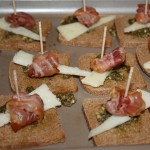
Berry cobbler is a sweet but (almost) healthy option for book club. Louise Erdrich’s book, The Round House, requires a saccharine dessert to offset its deep, weighty discussion.
Cranberry Bread – The Round House
This fruited bread is actually a Thanksgiving tradition in my house. We make multiple loaves and serve it with cream cheese. The combination is tangy, sweet, and unusual. And it is the perfect offering for your book club, as you discuss The Round House by Louise Erdrich.
Cranberry Bread
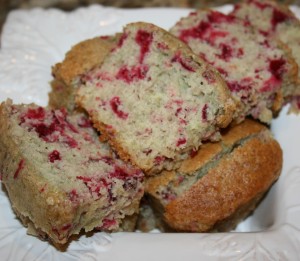 Ingredients
Ingredients
- 2 cups flour
- 1 cup sugar
- 1-1/2 teaspoons baking powder
- ½ teaspoon salt
- 2 Tablespoons butter or margarine, room temperature
- ¾ cup orange juice
- 1 egg (beaten)
- 1 cup cranberries, halved
- 1/2 cup chopped walnuts (optional)
Directions
Preheat the oven to 350 degrees.
Slice your cranberries in half and set aside. It helps to cut them frozen and slightly thawed. Or pop them in the freezer for a ½ hour before you plan to cut.
Grease two bread pans.
Mix dry ingredients and toss lightly.
Add butter, orange juice, and egg and stir vigorously until combined.
Once mixed, fold in cranberries (and walnuts, optional).
Pour batter into pan and spread evenly.
Bake at 350 degrees for 40-50 minutes. Insert a toothpick to make sure the centers are cooked and firm. Serve with cream cheese.
Walnuts can be added to this sweet bread for extra texture and crunch. There are few things I look forward to at Thanksgiving more than Cranberry Bread. It makes a simple, delicious addition to your book club discussion of The Round House by Louise Erdrich.
Inside the Writer’s Studio
 Recently I have been addicted to DVR’d episodes of Inside the Actor’s Studio with James Lipton. I find the discussion of craft fascinating and I appreciate the honest ask-then-listen aspect. There is no drama here, just active learning.
Recently I have been addicted to DVR’d episodes of Inside the Actor’s Studio with James Lipton. I find the discussion of craft fascinating and I appreciate the honest ask-then-listen aspect. There is no drama here, just active learning.
At the end of every interview, before the guest actor answers questions from the class, James Lipton asks the same ten revelatory questions. It’s interesting to hear different actors supply diverse answers to the same basic questions.
So recently, I posted the same ten questions to my Facebook friends (and if we aren’t Facebook friends, why not?) Once again, the diversity of the answers was riveting.
Nicole’s Answers to Mr. James Lipton
1. What is your favorite word?
Uxorious. Fun to say and spell and lovely to benefit from.
2. What is your least favorite word?
Wait.
3. What turns you on?
The sound of laughter. Drum beats.
4. What turns you off?
Elitism and guilt trips
5. What sound do you love?
Nature: Wind in the trees, bird trills, water rushing. My kids cracking up. The garage door opening, indicating my husband is home. The mail truck rounding the corner.
6. What sound do you hate?
Raised, angry voices, talk radio of ANY kind, sports commentators, sugar-sweet, simpering voices (Delilah and most DJs on Christian radio), and the old dialup squawk.
7. What is your favorite curse word?
Son of a bitch. (Because I require a mouthful of words rather than one concise one.)
8. What profession other than yours would you like to attempt?
Professional speaker or seminar presenter, likely on writing.
9. What profession would you not like to do?
Anything involving driving—truck driver, taxi driver, race car driver. I am nearly phobic about cars.
10. If heaven exists, what would you like to hear God say when you arrive at the pearly gates?
Everyone is here.
So you can imagine my pleasure when my good friend, Tara at Faith in Ambiguity, tagged me a question post. I don’t think Mr. Lipton will change his questions to hers but I found them fascinating to answers nonetheless.
1. Would you ever dissect a cat—if no one was using it and it was already dead? If so, why?
Probably, provided it wasn’t a pet of mine. I am sure I could use the experience somewhere in a future book or story.
And how does one use a dead cat?
2. Are you a writer or a blogger? Does your answer affect what you do?
I am a writer with a sporadic blog. But more specifically, I am a storyteller, plotter, editor, and terrible dawdler. Actual writing time is eclipsed by my preparations and procrastinations. This is not a good habit to cultivate.
3. Sushi—yes or no?
No. An emphatic no. Fire good.
4. What sorts of things really offend you, not just on an abstract level, but in day-to-day life?
A saccharine tone of voice gooey enough to induce cavities. Myopic surety in your absolute truth when you have a 0.01% view of the world. Sense of entitlement on the road (and in other places.)
5. What’s the one secret ingredient that brings life to your cooking (or, you know, your re-heated Lean Cuisines)?
Basil. The taste is a miraculous meld of summer sunlight, verdant verve, and melancholy.
6. Santa Claus: magical childhood delight or insult to children everywhere?
A long standing tradition of story, cause and effect, and a translation of our own childhood memories.
7. Name the best piece of short fiction you’ve ever read.
Killer Heart by Barb Johnson (Glimmer Train, issue 67). I reread it often to remind myself how to portion out a story.
8. Name a novel that changed your life.
My own. Not said with conceit, but I think it is impossible to write a book without effecting how you read books. Once I wrote a complete novel length book, I understood firsthand what a challenge it was. My respect for novelists and storytellers grew exponentially with every chapter I wrestled to the ground. Great writers became gods.
9. What is the thing that everyone likes but you, and even so, you know you’re right?
Reality shows. Everyone makes their arguments for their favorites. “They are cautionary tales.” “I only watch reality shows which involved talent/home improvement/weight loss/etc.” “It’s a guilty pleasure.” But I can’t tolerate them. They are a pale facsimile of story and should instantly trigger a mental assessment for those who want to participate.
10. If you’re on the right path, will you be happy? Or are some people called to walk a harder path?
As long as I am moving, I can be happy on most paths. I hate standstill traffic—in life and metaphorically.
As for harder paths, I do not claim to understand why I won the genetic and locality lottery. By being born white and middle class in the US, I have privileges the bulk of the world can only wish for. Locality also decides your religion so I take umbrage with the idea that the American God preassigned the bulk of the world into the wrong religion and greater hardships.
11. Name a really good soup that can be bought in a can.
Bean and Bacon soup. Much like yellow powdered macaroni cheese awakens childhood taste buds; the overprocessed bean soup is the familiar road home.
Maybe Mr. Lipton should consider adding to his question repertoire.
So let me ask you a question.
What startling idea have you recently tripped over?
Night Circus – Black and White Cookies on Red Velvet
The Le Cirque des Rêves is all about black and white, night and day. But the reveurs added a dash of scarlet red, to mark themselves to each other and to stand out. These gorgeous and soft cookies are the perfect nod to The Night Circus and its reveurs.
Red Velvet Black and White Cookies
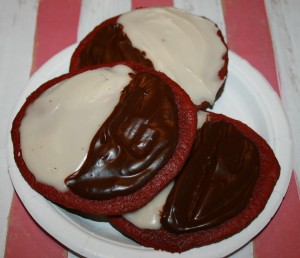 Adapted from Rachael Ray’s recipes (March 2008)
Adapted from Rachael Ray’s recipes (March 2008)
- 1-1/2 cups flour
- 1 Tablespoon cocoa powder
- ½ teaspoon salt
- 5 Tablespoons butter, at room temperature
- ¾ cup sugar
- 1 egg
- 1 Tablespoon red food coloring (or 1 teaspoon red food paste)
- 1 teaspoon vanilla extract
- ½ cup buttermilk
Preheat the oven to 350°.
Line two baking sheets with parchment paper. (Do not substitute foil or wax paper. Parchment paper is a must.)
Beat five tablespoons of butter with the sugar until fluffy. Beat in the egg, food coloring and 1 teaspoon vanilla.
Mix in cocoa powder, baking soda and salt until smooth.
Alternate 1-1/2 cups of flour and ½ cup buttermilk until it is all incorporated without overmixing.
Spoon about a 1/4-cup of batter 3 inches apart on the parchment papered baking sheet. Bake for 12-15 minutes at 35o degrees until the center is dry.
Let cookies cool for five minutes before removing from the parchment paper.
Black and White Frosting
- 2 cups confectioners’ sugar (10x sugar)
- 2 Tablespoons light corn syrup
- 3 Tablespoons butter, room temperature
- 3/4 cup semi-sweet chocolate chips
- 1 teaspoon vanilla extract
White Frosting
Whisk together the confectioners’ sugar, 1 teaspoon vanilla, 1 Tablespoon corn syrup and 2 Tablespoons hot water until smooth.
Black Frosting
In another bowl, combine the chocolate chips, remaining 3 Tablespoons butter, and 1 tablespoon corn syrup.
Microwave until melted, about 1 minute and stir vigorously. Microwave in 10 second increments until it is fully melted.
Frost the cookies with the white frosting, only covering half of the cookie, almost to the edge. Then frost with the chocolate icing, keeping a sharp edge. Cool until set. Store in an airtight container.
These classic cookies are the perfect cookie to accompany your book club discussion of Erin Morganstern’s The Night Circus. Serve them on a bright red platter with milk, coffee, or tea. The al dente frosting breaks smoothly over the yielding red velvet cookie creating a great mouth feel.
May words nourish your soul.
Night Circus – Discussion Questions
As a fellow participant of National Novel Writing Month (NaNoWriMo), I heard Erin Morgenstern’s name before she was actually published. Her debut book, The Night Circus, created a metric ton of ballyhoo prior to publication. She was touted as the next Harry Potter, even snagging the phenomenal Jim Dale to narrate the audio version of her magical book.
And like other NaNoWriMo success stories, the overnight success was preluded by years of hard work. “A very sprawling, very rough draft of The Night Circus was first written in a few different Novembers of NaNoWriMo. Almost the entire book was rewritten and revised before it got from there to the finished version. To give you an idea of how much: Celia isn’t in that first sprawling draft. It is a lot of stuff about the circus but not a lot of plot, but it gave me something to work from,” Erin has written on her blog.
But the professional polish and imaginative story stands alone, creating a wondrous world which will lasts long past the last page.
Book Synopsis
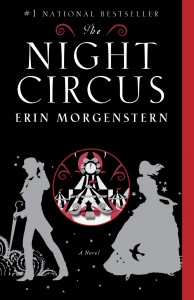 The circus arrives without warning. No announcements precede it. It is simply there, when yesterday it was not. Within the black-and-white striped canvas tents is an utterly unique experience full of breathtaking amazements. It is called Le Cirque des Rêves, and it is only open at night.
The circus arrives without warning. No announcements precede it. It is simply there, when yesterday it was not. Within the black-and-white striped canvas tents is an utterly unique experience full of breathtaking amazements. It is called Le Cirque des Rêves, and it is only open at night.
But behind the scenes, a fierce competition is underway: a duel between two young magicians, Celia and Marco, who have been trained since childhood expressly for this purpose by their mercurial instructors. Unbeknownst to them both, this is a game in which only one can be left standing. Despite the high stakes, Celia and Marco soon tumble headfirst into love, setting off a domino effect of dangerous consequences, and leaving the lives of everyone, from the performers to the patrons, hanging in the balance.
From Random House
Discussion Questions
Erin Morgenstern’s publisher, Random House, has a wonderful selection of book club discussion questions here. But as always, here at the Reader’s Feast, we have a few more questions to round out your discussion.
- The circus vignettes are disconnected from the narrative and written in second person, making them intimate, vivid, and memorable. Readers seldom encounter second person point of view. (Bright Lights, Big City by Jay McInerney is one of the few notable novels written in second person.) Was it jarring to you or did it draw you in? Could you imagine yourself at the circus?
- What tent or exhibition would you most want to visit? What foods would you want to taste? What feature would you avoid?
- Like magic, the story is revealed through sleights of hand—juggling the past with the present, hiding pertinent information until the last moment, and providing misdirection. How was the story enhanced (or lessened) by the tricks?
- Was it fair for the circus members to be pulled into a contract without their approval? Were the benefits (agelessness, travel, etc.) enough to outweigh the risks?
- Prospero has a mental and magical hold on Celia, including after his “death.” How can a ghost of a person be stronger than a real person?
- Marco and Celia struggle with balancing the ever-expanding circus. How is this a reflection of how we overextend ourselves?
- There are several pairings in The Night Circus. Marco and Celia, Poppet and Widget, Celia and Herr Thiessen, Marco and Isobel, and Tara and Lanie Burgess. Bailey is one of the few unpaired individuals. How does this make him different? Would he make a different decision about joining the circus if he was paired? Is Poppet enough for him or is she too closely paired to Widget to fully give herself to Bailey?
- Have you ever been behind the scenes of a circus, a play, a restaurant, a special production, etc? What was disconcerting about the behind the scene look? What took you by surprise?
- The reveurs were like followers of a cult. Today’s culture offers several cult options, such as certain events, movie franchises, some stories, etc. What elements are often found in a cult? (Some ideas: a universal truth, compelling characters, likeminded individuals, common ground, etc.)
- Who would you cast in the movie of The Night Circus, which is in the works?
- The circus would be nothing without its audience. Why do stories need to be told and heard to release their power?
The Night Circus by Erin Morgenstern is as magical as its many, varied tents. It is a book that invites us to visit repeatedly—studying for the sleights of hand, reimagining the character’s motivations and desires, and relishing its promised delicacies.
On Wednesday, I will share the recipe for Black and White Red Velvet cookies, with a nod towards the reveurs of the Le Cirque des Rêves.


